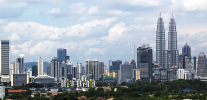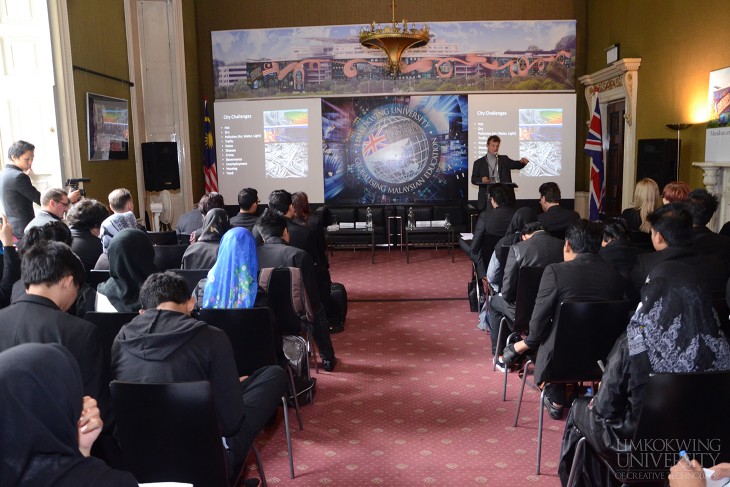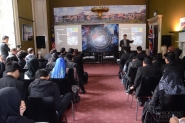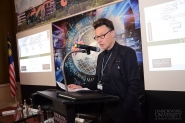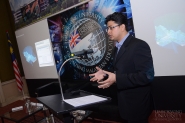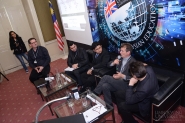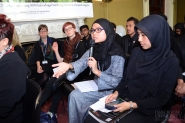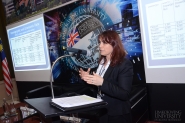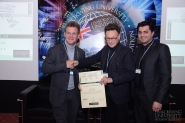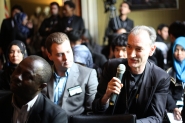- The “Sustainability +/- Collapse” Symposium at Limkokwing University's London Campus.
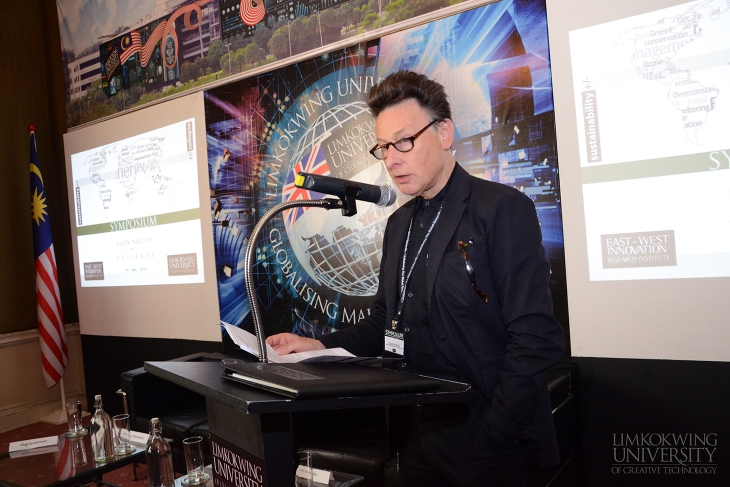 Dr. Jake Morton, Limkokwing London’s Academic Leader, outlining the topics of the symposium.
Dr. Jake Morton, Limkokwing London’s Academic Leader, outlining the topics of the symposium.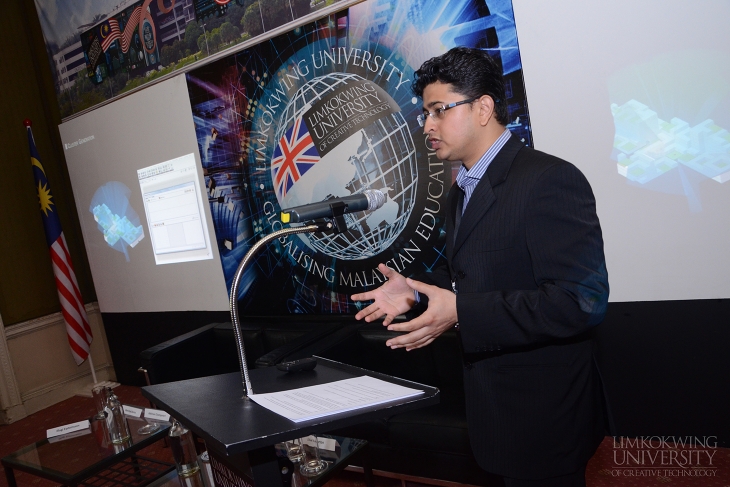 Mr. Abhinav Champaneri of the Architectural Association explaining his findings.
Mr. Abhinav Champaneri of the Architectural Association explaining his findings.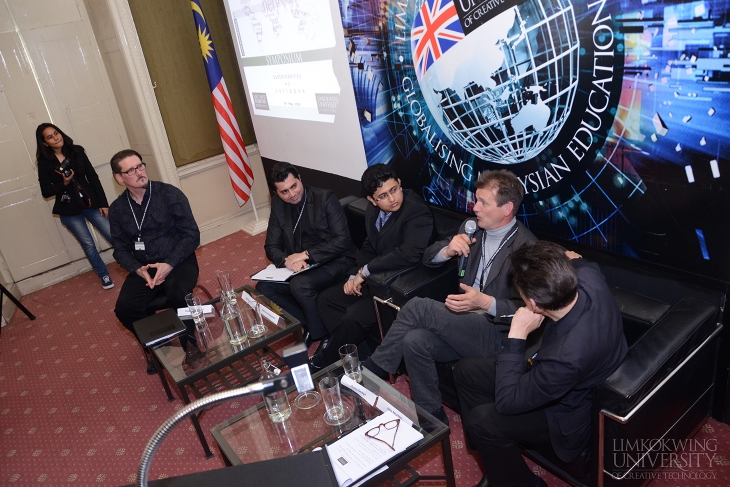 The presenters doing the question/answer session.
The presenters doing the question/answer session.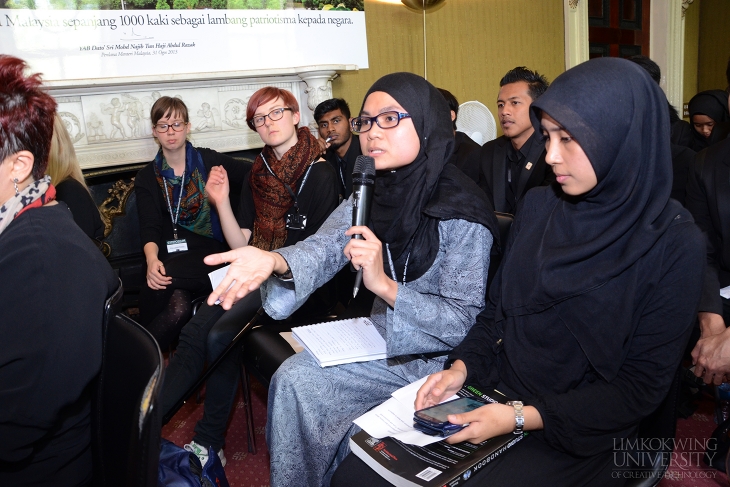 An interesting question from one of the inquisitive students.
An interesting question from one of the inquisitive students.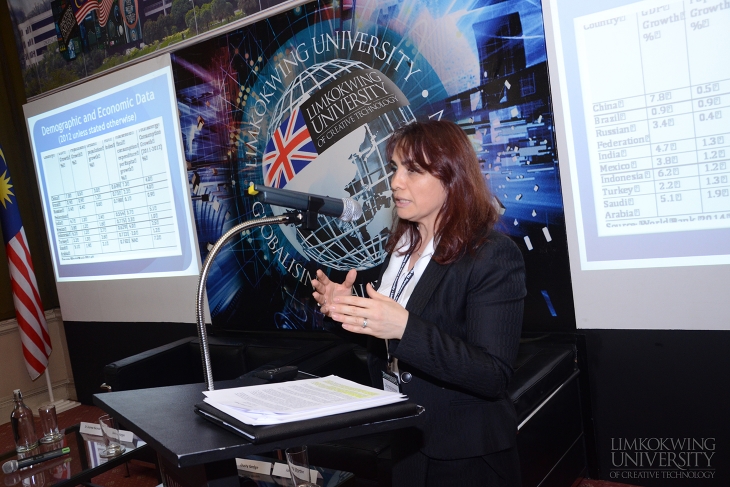 Dr. Zeynep Kacmaz with her presentation.
Dr. Zeynep Kacmaz with her presentation.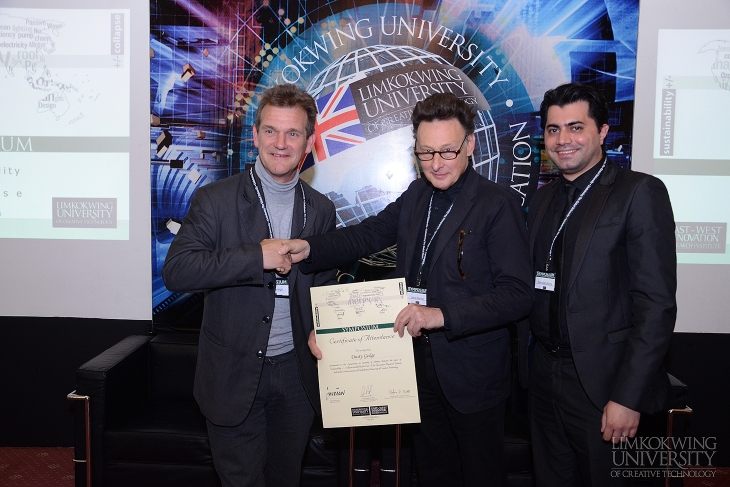 Mr. Dusty Gedge, President of the European Green Roofs Associations, receiving his certificate of attendance.
Mr. Dusty Gedge, President of the European Green Roofs Associations, receiving his certificate of attendance.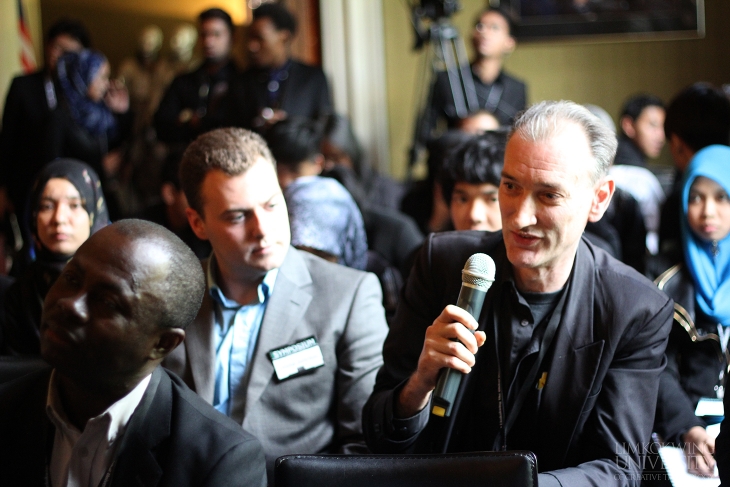 The lively participation during the question/answer session.
The lively participation during the question/answer session.
Organised by Limkokwing University’s East West Innovation Research Institute at the London Campus of Limkokwing University of Creative Technology, the “Sustainability +/- Collapse” Symposium investigated the question of whether sustainability itself was a sustainable concept, and whether or not its failure would necessarily incur environmental collapse.
Chair of the Symposium, Mr. Mehrdad Borna, introduced the symposium to the participants by addressing his thanks to Limkokwing University’s Founder and President Tan Sri Dato’ Sri Paduka Dr Lim Kok Wing for the opportunity and the gracious hosting of the symposium. Mr. Borna cited the President’s message to the East-West Innovation Research Institute, saying that the President’s words proved a perfect application to the symposium: “As a university of creative technology and innovation I consider this a most fitting location to gather you like-minded people in address of urgent global issues you shall treat today. The East West Innovation Research Institute was established to bring together the two sides of the world to enable better understanding of what needs to be done. Experts on both sides of the world must see that it is their responsibility to bridge the gaps in public understanding of global issues that impact their lives.”
The proceedings continued with a welcome plenary address by Dr. Jake Morton, Limkokwing London’s Academic Leader, which outlined the topics of the symposium to speakers and guests. Dr. Morton introduced and thanked the speakers for their presence and topics’ contributions.
Mr. Dusty Gedge, as President of the European Green Roofs Associations, then took to the podium to present his keynote address to start the symposium proper. This highly respected and internationally experienced activist and agitator for the address and resolution of environmental threats proceeded to enumerate the many aspects and facets of the environmental crisis and the measures and technologies instrumental in their resolve. Imminent and seminal amongst these are the potentials of the ‘Green Roof’ for the re-ventilation and re-cultivation of urban environments as forms of auxiliary parklands. His presentation revealed many strategies and their implications and his energetic and inspiring presentation succeeded in establishing the platform for the following speakers which provided a fittingly diverse investigation into urban design responses to sustainability.
This was led by Mr. Abhinav Champaneri of the Architectural Association: a seat of architectural pedagogy renowned for its radical and always entirely original productions and sponsor of many leading figures of all generations such as Richard Rogers, Norman Foster, Rem Koolhaus and Zaha Hadid among others. He addressed the research of measures to modify and moderate climatic extremes and topographies and to manipulate and determine urban temperature and weather conditions with profundity and incision explaining how in many cases his findings revealed the efficacy and intelligence of highly traditional, and often very ancient, solutions. The quality of the slides presented, of both hand-drawn sketches and diagrammatic illustrations was also exemplary.
This exposition, having set the scene was then followed by another urban study, presented by symposium chairman Mr Mehrdad Borna, in his capacity as Limkokwing University Academic Co-ordinator and Senior Lecturer, who gave an expert explication of his close study of the effects of recently sited high-rise buildings in Bermondsey Square: “How the various types of social interactions and behaviours are influenced by the micro-climate of the space”. This site had previously been a thriving communal node hosting a busy street market and street level shops and cafes, but following the erection of the new structures major part of the market had moved to other sites due to the high winds and their cold-chill temperatures proving too uncomfortable for pedestrian gatherings, leaving the square uninhabited and deserted by human.
Mr. Borna technically demonstrated the effect of the buildings in terms of the wind and temperature flows in visual format from aggregated close surveys of all aspects and zones of the site by tonal images generated by digital processing. This very clearly pictured the directions, routes and gradations of wind and temperature and proved with scientific rigour the papers’ hypothesis of the detrimental effects of building design and urban structuring without due anticipatory reference to their generated local climatic effects and consequent social-behavioural outcomes thus making a powerful plea for more environmental awareness and sensibility.
At the end of Mr. Borna’s presentation, symposium broke for luncheon where discussion and networking between speakers and students ensued, providing useful networking opportunities.
Following the luncheon break the third speakers, Dr. Zeynep Kacmaz and Prof. Dr. Semra Atabay from Bradford University and Yildiz Technical University, Turkey addressed “Conflicting Issues pertaining to Development and Climate Change”. Their paper closely examined the extant data available yielding late quantitative survey material of principal low-performance countries in order to research potential evidence of their performances of programmes aimed at reducing greenhouse gas emissions arising from overpopulation and contingent amplifications of production and consumption cycles.
In this presentation, the plans and reports issued by the countries experiencing emergent economies (China, Brazil, Russian Federation, India, Mexico, Indonesia, Turkey, Saudi Arabia and Japan) are closely examined, analysed and discussed with illuminating and often unexpected outcomes: “The major player among these countries is China as it is almost producing by itself one third of world emissions, however per capita emissions are very low compared fossil fuel producing countries such as Russian Federation and Saudi Arabia.” While: “The increase in China’s CO2 emissions was mainly due to a continued high economic growth rate, with related increases in fossil fuel consumption.” The several analyses of the findings identified gaps and advantages in the strategy making of the several countries and was particularly productive in identifying comparative criteria and the location of barriers, effecting a truly international legislative framework for synthesising strategic programmes and outcomes between the developing-economy nations.
Finally, Ms. Gloria Vargas, of the University of Sheffield, presented her paper: “Exploring the significance of thermal experiences in transitional spaces: an approach towards adaptive opportunities in buildings to tolerate changing climates”. This paper revealed very close surveying of user sensibility to small, relatively micro-alterations in temperatures, which can inform the precise requirements of temperature control systems and measures for optimum comfort, yielding insightful results which question the automatic use of heating and air cooling systems. These were surveyed in four comparative circumstances and sites: the exterior conditions of the building locality; those of the initial interior reception space; those of a secondary interior, linking space like a corridor, and the final fully internal arrival space.
Very slight variations in temperature between these spaces were found to be affective upon individuals. In extreme external climates air-conditioning and heating, in buildings public and private, as well in transportation systems, were most often counter-productive, producing discomforting effects by the sudden extremes of temperature experienced, often in sequences of rapid succession, and also resulting in the de-sensitising of the subjects to more moderate distinctions. Whereas, with the implementation of highly moderated changes in temperature a greater sensibility is cultivated which is thus more responsive to their distinctions and often only a single degree of temperature variation can produce greater comfort as a response.
Ms. Vargas’ paper showed that the implications for the reduction in energy consumption and pollution productions - as well as financial saving - obtained by these reductions in synthetic measures, when viewed on a global scale, promise to be enormous. Findings included conclusions that people’s thermal comfort is dynamic and inclusions of variability in daily experience create better long term adaptations and perceptions of comfort which would contribute positively to these potential economies.
Following each presentation a question/answer session was provided in which many incisive enquiries were made from delegates and students present, encouraging debate and insightful discussions with the presenters. The students’ responses were lively and inquisitive reflecting an effective grasp and understanding of the often quite complex concepts entailed by the several papers.













